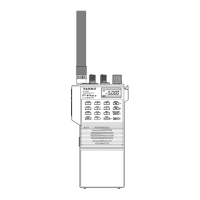
Do you have a question about the Yaesu FT-411 MKII and is the answer not in the manual?
| Frequency Range TX | 144-146 MHz |
|---|---|
| Mode | FM |
| Output Power | 5 W |
| Voltage | 12 VDC |
| Current Drain RX | 150 mA |
| Current Drain TX | 1.5 A |
| Impedance | 50 Ω |
| Antenna Connector | BNC |
| Receiver Sensitivity | 0.25 μV (12 dB SINAD) |
General technical specifications including frequency coverage, channel steps, emission type, and current consumption.
Detailed receiver specifications such as circuit type, sensitivity, adjacent channel selectivity, and intermodulation.
Transmitter technical data including power output, frequency stability, modulation system, and maximum deviation.
Information on compatible rechargeable Ni-Cd battery packs and dry cell cases for the transceiver.
Step-by-step instructions for safely removing and installing battery packs on the transceiver.
Details on various AC and DC chargers available for recharging the transceiver's battery packs.
Description of optional speaker/microphones and earpiece/mics for enhanced audio and communication.
Guidance on selecting, connecting, and impedance matching antennas for optimal radio performance.
Instructions for installing the optional CTCSS Tone Squelch Unit to enable tone squelch features.
Description of controls and connectors located on the top panel, including audio jacks and dial selector.
Details of controls and connectors found on the side panels, such as PTT, monitor, and unlock lever.
Overview of indicators and controls on the front panel, including the busy/TX lamp, keypad, and LCD display.
Initial setup steps and general operating guidelines, including battery charging and antenna connection.
Procedure for adjusting the squelch control to silence background noise and optimize reception sensitivity.
Explanation of keypad functions, alternate key presses, beep settings, and keypad locking mechanisms.
Methods for tuning frequencies and adjusting channel step sizes in VFO mode using keys and dial.
Instructions on how to transmit, including power level selection, PTT usage, and BUSY/TX indicator.
Explanation of automatic repeater shift (ARS) and manual offset adjustments for repeater communication.
Guide to reprogramming the default repeater frequency offset value used by ARS and manual shifts.
Steps for storing frequencies, repeater shifts, and tone data into the transceiver's memory channels.
Methods for accessing stored memory channels and copying memory data to VFO frequencies.
Techniques for masking memories to hide them from operation or permanently erasing stored data.
Procedure for storing and recalling the dedicated emergency or call channel for quick access.
How to activate and configure transceiver scanning features, including pause and resume modes.
Method for marking specific memories to be skipped during scanning operations while allowing manual access.
Utilizing special memories 'L' and 'U' for defining custom programmable scan ranges between frequencies.
Setting up and using priority channel monitoring to automatically check an important frequency.
Sequentially monitoring multiple memory channels for priority signals while operating on a VFO.
Using CTCSS tones for selective squelch control and activating pager alert functions.
Configuring power saving modes, including duty cycle ratios, to extend transceiver battery life.
Setting the automatic power-off timer to conserve battery by shutting down the transceiver.
Enabling hands-free transmission using voice activation, with adjustable sensitivity settings.
Storing and recalling DTMF tone sequences for autopatch or remote control operations.
Restoring transceiver programmable features and settings to their original factory default parameters.
